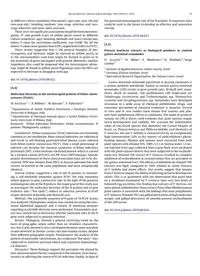
2010 Molecular diversity in the nucleocapsid protein of feline coronaviruses (FCoVs) PDF
Preview 2010 Molecular diversity in the nucleocapsid protein of feline coronaviruses (FCoVs)
Special Abstracts / Journal of Biotechnology 150S (2010) S1–S576 S3 in different culture conditions (four ponds), ages (one-year-old and two-year-old), breeding methods (one-stage selection and two- stage selection) and sexes were assessed. There were no significant associations found between heterozy- gosity, d2 and growth traits of yellow perch reared in different culture conditions, ages, breeding methods and sexes (except one, where P value for correlation coefficients was 0.046; for all the others, P values were greater than 0.05, ranged from 0.063 to 0.975). These results suggested that i) the general thoughts of het- erozygosity and heterosis might be rejected in yellow perch, or ii) the microsatellites used here might be located in genes or in the proximity of genes uncoupled with growth. Moreover, another hypothesis also could be proposed that the heterozygote advan- tage might be found in yellow perch fingerlings since the HFCs are expected to decrease or disappear with age. doi:10.1016/j.jbiotec.2010.08.022 [A.4] Molecular diversity in the nucleocapsid protein of feline coron- aviruses (FCoVs) M. Battilani 1,∗, A. Balboni 1, M. Bassani 1, S. Paltrinieri 2 1 Dipartimento di Sanità Pubblica Veterinaria e Patologia Animale, Università di Bologna, Italy 2 Dipartimento di Patologia Animale Igiene e Sanità Pubblica Veteri- naria, Università di Milano, Italy Keywords: Feline Infectious Peritonitis; Feline coronaviruses; N protein; Phylogenetic analysis Introduction: Feline coronavirus (FCoV) infections are extremely common in cats worldwide. Most natural infections are subclinical and result in self-limiting gastrointestinal disease (cases infected with feline enteric coronavirus FECV). Only a small percentage of infected cats develop the classical symptoms of feline infectious peritonitis (FIP), a fatal immune-mediated disease which is caused by a virulent variant of FCoVs, the FIP virus (FIPV biotype). Specific genetic determinants of these clinical outcomes have yet to be dis- covered. FIPV was distinct from FECV in disease potential but both viruses co-existed in the same population and were antigenically identical. Several studies suggested a role of the N protein in stimulat- ing a cell-mediated immunity against FCoV, the only immunity which appears to play a protective role. In the light of the putative immunogenic role of the N protein, the major goal of this study was to investigate the molecular diversity of the N protein and to give evidence sites (“hot spots”) subject to selective pressure in FCoV strains detected in healthy and diseased cats. Methods: The nucleotide sequence of N gene of 74 FCoV strains was analysed. Phylogenetic analysis was carried out using the max- imum likelihood approach and a variety of statistical analyses regarding nucleotide diversity were performed. Datamonkey anal- ysis was carried out to determine whether particular sites in the N gene were subjected to positive selection. Results: Phylogeny showed a general clustering trend on the basis of geographic origin rather than on virulence characteris- tics, but it also showed a strict correlation between some avirulent strains detected in chronic carrier cats and virulent strains, despite their different geographic origins. Furthermore, the analysis of the pattern of nucleotide substitutions, has evidenced “hot spots” sites subjected to selective pressure which may represent immunologi- cal domains. Discussion: These findings support the prevalent role played by host and enviroment factors compared to the intrinsic viral charac- teristics in affecting the course of FCoV infection. Finally, in light of the potential immunogenic role of the N protein, N sequences data could be used in the future to develop an effective and innovative vaccine. doi:10.1016/j.jbiotec.2010.08.023 [A.5] Pistacia lentiscus extracts as biological products to control gastro-intestinal nematodes H. Azaizeh 1,∗, N. Abbas 1, A. Markovics 2, H. Muklada 3, Serge Landau 3 1 Institute of Applied Research, Galilee Society, Israel 2 Vetrinary Kimron Institute, Israel 3 Agricultural Research Organization, the Volcani Center, Israel Gastro-intestinal nematode parasitism in grazing ruminants is a serious problem worldwide. Failure to control gastro-intestinal nematodes (GIN) results in poor growth rates, ill-thrift and, some- times, death of animals. The predominant GIN implicated are Teladorsagia circumcincta and Trichostrongylus spp. Haemonchus contortus and Oesophagostomum spp. Nematodes have developed resistance to a wide array of chemical anthelmintic drugs, and consumer perception of chemical treatment is negative. Several in vitro and in vivo studies have shown that tannins and phe- nols have anthelmintic effects in ruminants. The mode of action of tannins on GIN is direct, with evidence that plant tannins impair larval development and viability. We assessed the anthelmintic value of two brush species that dominate the Carmel Heights of Israel; i.e. Pistacia lentiscus and Phillyrea latifolia. Leaf chemistry of P. lentiscus, but not P. latifolia is characterized by an exceptionally high concentration (20% in dry matter) of poly(ethylene)-glycol- binding tannins. Phenols and tannins were extracted from both plant species with ethanol 70%, 100% (v/v), or boiling water. L3 lar- vae hatched from eggs collected from a goat flock were incubated with the plant extracts before they were subjected to the exsheath- ment test. Ethanol 70% extract of P. lentiscus resulted in complete inhibition of exsheathment at concentrations that are prevalent in the gastro-intestinal tract. The efficacy of inhibition by ethanol 70% extracts was high, compared to 100% ethanol or water. Extracts of P. latifolia had minor effects. Our results suggest that tannins from P. lentiscus impair the ability of infecting larvae to develop into adults. This is in agreement with our observation that goats kept on a shrubland dominated by P. lentiscus have very low levels of helminth egg excretion. Our finding that extracts of P. lentiscus are more potent anthelmintics than extracts from other Mediterranean plant species is consistent with the findings that most polyphenols in P. lentiscus (Ethanol 70%) are galloyl derivatives of high molecular weight, and galloyl derivatives of catechin prevent exsheathment of the GIN larvae. doi:10.1016/j.jbiotec.2010.08.024
